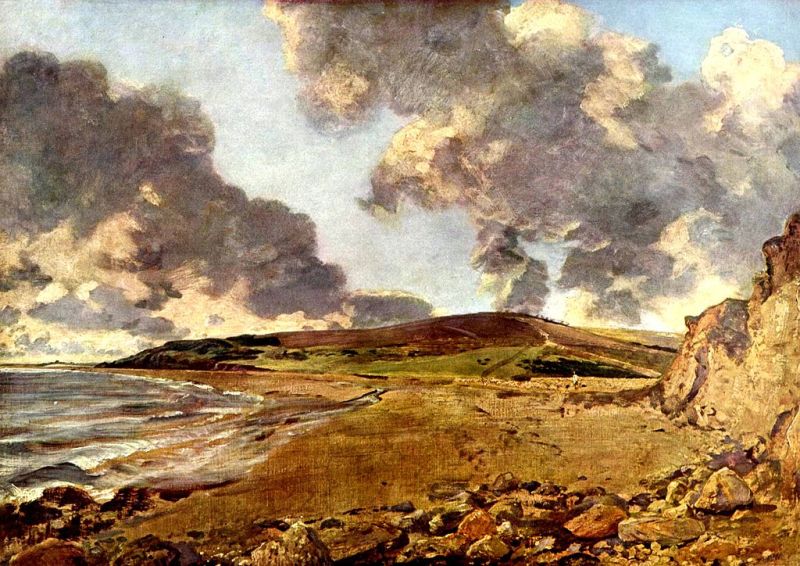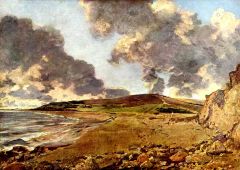Weymouth Bay (c. 1816)
16x20 inches=$ 169 ,
20x24 inches=$ 219 ,
24x36 inches=$279 ,
30x40 inches=$ 339 ,
36x48 inches=$ 399 ,
48x72 inches=$ 629,
Note: 1 inches=2.54 cm
Artist Introduce:
John Constable, RA (11 June 1776 - 31 March 1837) was an English Romantic painter. Born in Suffolk, he is known principally for his landscape paintings of Dedham Vale, the area surrounding his home—now known as "Constable Country"—which he invested with an intensity of affection. "I should paint my own places best", he wrote to his friend John Fisher in 1821, "painting is but another word for feeling".
His most famous paintings include Wivenhoe Park of 1816,Dedham Vale of 1802 and The Hay Wain of 1821. Although his paintings are now among the most popular and valuable in British art, Constable was never financially successful. He did not become a member of the establishment until he was elected to the Royal Academy at the age of 52. His work was embraced in France, where he sold more works than in his native England and inspired the Barbizon school.
Early career
John Constable, Self-portrait 1806, pencil on paper, Tate Gallery London. His only indisputable self-portrait, drawn by an arrangement of mirrors.
John Constable was born in East Bergholt, a village on the River Stour in Suffolk, to Golding and Ann (Watts) Constable. His father was a wealthy corn merchant, owner of Flatford Mill in East Bergholt and, later, Dedham Mill in Essex. Golding Constable owned a small ship, The Telegraph, which he moored at Mistley on the Stour estuary, and used to transport corn to London. He was a cousin of the London tea merchant, Abram Newman. Although Constable was his parents' second son, his older brother was intellectually disabled and John was expected to succeed his father in the business. After a brief period at a boarding school in Lavenham, he was enrolled in a day school in Dedham. Constable worked in the corn business after leaving school, but his younger brother Abram eventually took over the running of the mills.
In his youth, Constable embarked on amateur sketching trips in the surrounding Suffolk and Essex countryside, which was to become the subject of a large proportion of his art. These scenes, in his own words, "made me a painter, and I am grateful"; "the sound of water escaping from mill dams etc., arts, old rotten planks, slimy posts, and brickwork, I love such things."He was introduced to George Beaumont, a collector, who showed him his prized Hagar and the Angel by Claude Lorrain, which inspired Constable. Later, while visiting relatives in Middlesex, he was introduced to the professional artist John Thomas Smith, who advised him on painting but also urged him to remain in his father's business rather than take up art professionally.
Dedham Vale (1802)
In 1799, Constable persuaded his father to let him pursue a career in art, and Golding granted him a small allowance. Entering the Royal Academy Schools as a probationer, he attended life classes and anatomical dissections, and studied and copied old masters. Among works that particularly inspired him during this period were paintings by Thomas Gainsborough, Claude Lorrain, Peter Paul Rubens, Annibale Carracci and Jacob van Ruisdael. He also read widely among poetry and sermons, and later proved a notably articulate artist. By 1803, he was exhibiting paintings at the Royal Academy.
In 1802 he refused the position of drawing master at Great Marlow Military College, a move which Benjamin West (then master of the RA) counselled would mean the end of his career. In that year, Constable wrote a letter to John Dunthorne in which he spelled out his determination to become a professional landscape painter:
“ For the last two years I have been running after pictures, and seeking the truth at second hand... I have not endeavoured to represent nature with the same elevation of mind with which I set out, but have rather tried to make my performances look like the work of other men...There is room enough for a natural painter. The great vice of the present day is bravura, an attempt to do something beyond the truth. ”
His early style has many qualities associated with his mature work, including a freshness of light, colour and touch, and reveals the compositional influence of the old masters he had studied, notably of Claude Lorrain. Constable's usual subjects, scenes of ordinary daily life, were unfashionable in an age that looked for more romantic visions of wild landscapes and ruins. He made occasional trips further afield.
Wivenhoe Park (1816)
In 1803 he spent almost a month aboard the East Indiaman ship Coutts as it visited south-east ports, and in 1806 he undertook a two-month tour of the Lake District.He told his friend and biographer, Charles Leslie, that the solitude of the mountains oppressed his spirits, and Leslie wrote:
“ His nature was peculiarly social and could not feel satisfied with scenery, however grand in itself, that did not abound in human associations. He required villages, churches, farmhouses and cottages. ”
To make ends meet, Constable took up portraiture, which he found dull, though he executed many fine portraits. He also painted occasional religious pictures but, according to John Walker, "Constable's incapacity as a religious painter cannot be overstated."
Constable adopted a routine of spending winter in London and painting at East Bergholt in summer. In 1811 he first visited John Fisher and his family in Salisbury, a city whose cathedral and surrounding landscape were to inspire some of his greatest paintings.
Marriage and later life
Maria Bicknell, painted by Constable in 1816
From 1809, his childhood friendship with Maria Elizabeth Bicknell developed into a deep, mutual love. Their marriage in 1816 when Constable was 40 was opposed by Maria's grandfather, Dr Rhudde, rector of East Bergholt. He considered the Constables his social inferiors and threatened Maria with disinheritance. Maria's father, Charles Bicknell, solicitor to King George IV and the Admiralty, was reluctant to see Maria throw away her inheritance. Maria pointed out to John that a penniless marriage would detract from any chances he had of making a career in painting. Golding and Ann Constable, while approving the match, held out no prospect of supporting the marriage until Constable was financially secure. After they died in quick succession, Constable inherited a fifth share in the family business.
Weymouth Bay (c. 1816)
John and Maria's marriage in October 1816 at St Martin-in-the-Fields (with Fisher officiating) was followed by time at Fisher's vicarage and a honeymoon tour of the south coast. The sea at Weymouth and Brighton stimulated Constable to develop new techniques of brilliant colour and vivacious brushwork. At the same time, a greater emotional range began to be expressed in his art.
Although he had scraped an income from painting, it was not until 1819 that Constable sold his first important canvas, The White Horse, which led to a series of "six footers", as he called his large-scale paintings. That year he was elected an Associate of the Royal Academy. In 1821 he showed The Hay Wain (a view from Flatford Mill) at the Academy's exhibition. Théodore Géricault saw it on a visit to London and praised Constable in Paris, where a dealer, John Arrowsmith, bought four paintings, including The Hay Wain. It was exhibited at the Paris Salon of 1824, winning a gold medal.
Of Constable's colour, Delacroix wrote in his journal: "What he says here about the green of his meadows can be applied to every tone". Delacroix repainted the background of his 1824 Massacre de Scio after seeing the Constables at Arrowsmith's Gallery, which he said had done him a great deal of good.
In his lifetime, Constable sold only 20 paintings in England, but in France he sold more than 20 in just a few years. Despite this, he refused all invitations to travel internationally to promote his work, writing to Francis Darby: "I would rather be a poor man [in England] than a rich man abroad."In 1825, perhaps due partly to the worry of his wife's ill-health, the uncongeniality of living in Brighton ("Piccadilly by the Seaside"), and the pressure of numerous outstanding commissions, he quarrelled with Arrowsmith and lost his French outlet.
After the birth of their seventh child in January 1828, Maria fell ill and died of tuberculosis on 23 November at the age of 41. Intensely saddened, Constable wrote to his brother Golding, "hourly do I feel the loss of my departed Angel—God only knows how my children will be brought up...the face of the World is totally changed to me".























